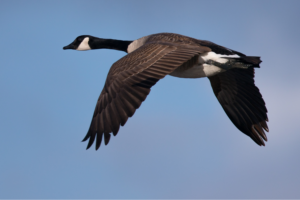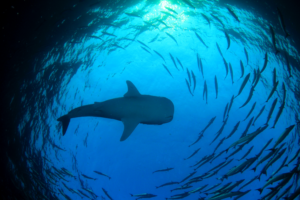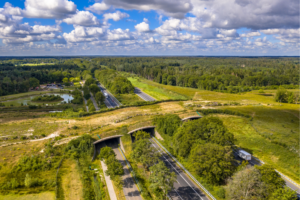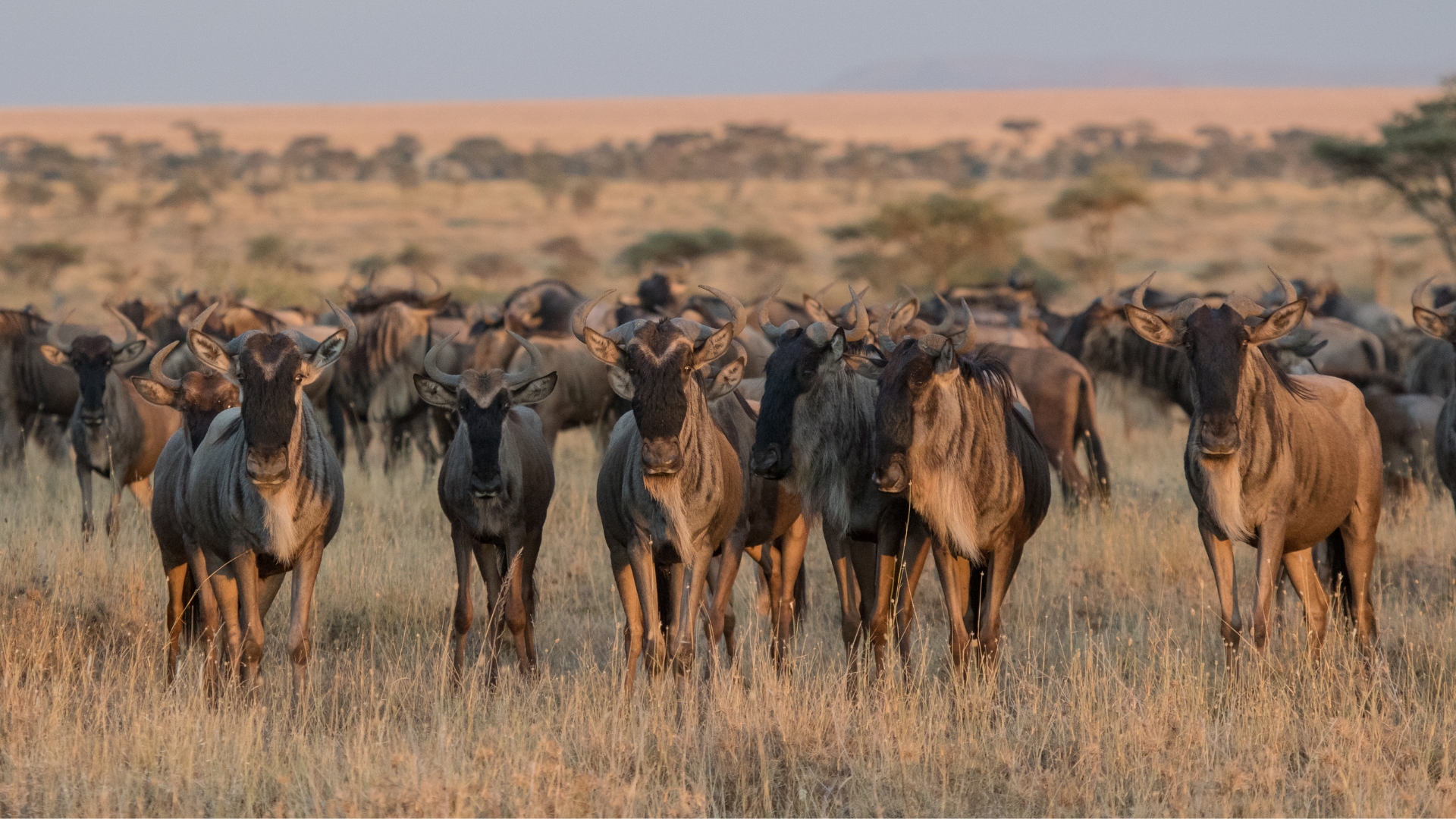Report: Mounting threats to migratory species
Written by Olivia Nater | Published: February 16, 2024
A new UN report found that one in five assessed migratory animals are threatened with extinction due to human activities. The main drivers of decline are habitat loss and overexploitation, but pollution and climate change represent additional major and growing threats.
What is a migratory species?
 If you live in the southern United States, you may currently be seeing a bird that you don’t see during warmer times of the year. The Canada goose spends the summer months breeding in Canada and in the northern U.S. While some populations stay in the same area year-round, others move south in search of more easily accessible food in the winter. Seeing large, often noisily honking groups swoop across the sky in their characteristic V-formations usually signals changing seasons.
If you live in the southern United States, you may currently be seeing a bird that you don’t see during warmer times of the year. The Canada goose spends the summer months breeding in Canada and in the northern U.S. While some populations stay in the same area year-round, others move south in search of more easily accessible food in the winter. Seeing large, often noisily honking groups swoop across the sky in their characteristic V-formations usually signals changing seasons.
The United Nations Convention on the Conservation of Migratory Species of Wild Animals (CMS), defines a migratory animal as “The entire population or any geographically separate part of the population of any species or lower taxon of wild animals, a significant proportion of whose members cyclically and predictably cross one or more national jurisdictional boundaries.”
Thousands of species, from birds, to whales, to insects, migrate seasonally to find food, mates, and suitable breeding grounds. However, our human population of 8 billion and counting now appropriates so much land and engages in so many damaging activities that critical migration routes are being blocked, key habitats destroyed, and entire animal populations depleted. The dead juvenile North Atlantic right whale that washed ashore on Martha’s Vineyard in January is a sad poster child for the adversity faced by many migratory species today. The endangered whale was entangled in lobster fishing gear.
CMS, also known as the “Bonn Convention,” is an international treaty and organization launched in Bonn, Germany, in 1979 dedicated to the conservation and sustainable management of migratory animals and their habitats. Last week, it published its first-ever global assessment of the conservation status of migratory species, and the findings are predictably dire.
How threatened are migratory species?
CMS lists 1,189 animal species that have been recognized by the 133 CMS Parties as needing international protection. According to the report, nearly half (44 percent) of these species have declining populations, and 22 percent have been assessed as threatened with extinction on the IUCN Red List. The CMS report also looked at over 3,000 additional migratory species not listed by CMS.
It found that extinction risk for migratory species is growing globally. In addition, over half of key biodiversity areas considered important for migratory animals are not protected and are under unsustainable human pressures.
Some taxonomic groups are considerably worse off than others. For example, 97 percent of fish listed under the convention are threatened with extinction, and these species have on average experienced a staggering 90 percent decline in abundance since 1970. Reptiles are also badly affected, with 70 percent of listed species threatened.
Over the past 30 years, 70 CMS-listed migratory species have become more endangered, while only 14 listed species have seen an improvement in their conservation status — these include blue and humpback whales, which have benefitted from the international moratorium on commercial whaling.
Drivers of decline
The two greatest threats to migratory species are habitat loss and overexploitation, the same two main drivers of overall biodiversity loss. Three out of four CMS-listed species are impacted by habitat loss, degradation, and fragmentation, and seven out of ten are impacted by overexploitation (hunting and fishing as well as incidental capture, such as bycatch).
Just under half of listed species are impacted by climate change, and around 40 percent are impacted by pollution, including pesticides, plastics, heavy metals, excess nutrients (from fertilizer run-off), and noise and light.
Habitat loss
The report notes,
“The expansion of agriculture to meet the demands of growing human populations is a key driver of the habitat loss, degradation, and fragmentation that affects many migratory species. Approximately 46% of the world’s terrestrial land surface (that is habitable by humans) is agricultural land.”
The Serengeti-Mara ecosystem in Tanzania and Kenya, for example, is experiencing intense pressure from the expansion of agriculture, settlements, roads, and fences. This negatively impacts the quality and availability of habitat for some of the world’s largest populations of migratory animals, including wildebeest and zebra, which support CMS-listed predators such as cheetahs, lions, and wild dogs.
In Europe, the extensive modification and fragmentation of rivers has drastically reduced the suitability of these freshwater habitats for migrating European eels.
Overexploitation
 Overfishing is the primary threat to fish species, including sharks and rays. While not very many shark and ray species are intentionally targeted, this taxonomic group is heavily impacted by incidental entanglement in fishing gear (bycatch).
Overfishing is the primary threat to fish species, including sharks and rays. While not very many shark and ray species are intentionally targeted, this taxonomic group is heavily impacted by incidental entanglement in fishing gear (bycatch).
Global populations of oceanic sharks and rays have declined by an average of 71 percent since 1970 due to rising fishing pressures. The report notes that the massive threat from industrial fisheries has been compounded by the expansion of small-scale, artisanal fisheries over recent decades. The latter have contributed significantly to the decline of species found in shallower coastal waters, such as sawfishes and wedgefishes.
Climate change
The world’s only tusked whale, the narwhal, lives in Arctic waters — it avoids sea water temperatures above 2°C and relies on the availability of sea ice for hunting. Rising ocean temperatures and melting sea ice are expected to dramatically decrease suitable habitat for the narwhal. In light of the critical global warming threshold of 1.5°C likely to be breached within the next few years, the future of this mysterious species is uncertain.
Sea turtles’ sex is determined by temperature while they are still in the egg — cooler eggs turn into males, while warmer eggs turn into females. A recent study of green turtles living on the Great Barrier Reef found that 99 percent of juvenile turtles were female — this extreme imbalance in the sex ratio could have serious implications for this species’ propagation.
Pollution
Contamination of the environment with pollutants as well as increasing anthropogenic noise and artificial light are growing threats to biodiversity around the world. The report notes that light pollution contributes to the deaths of millions of birds annually, largely through collision with buildings. Underwater noise pollution from shipping vessels has been shown to disrupt foraging behavior in many dolphins and whales, and high-intensity sounds such as military sonar are thought to play a role in fatal stranding events.
Plastic pollution frequently kills marine mammals and sea birds, which ingest it or get entangled by discarded fishing gear (called “ghost gear”). Agricultural runoff from farms can cause ocean dead zones, and pesticides are decimating insect populations across the world. Industrial activities are also continuously releasing toxic chemicals, including persistent organic pollutants (POPs), into the environment, which poison both migratory and non-migratory species.
Protecting migratory species

To reverse the decline in migratory species, the authors of the CMS report call for tackling illegal and unsustainable fishing and hunting, improving the protection and connection of important sites for migratory species, and scaling up efforts to fight climate change, as well as light, noise, chemical, and plastic pollution.
Unfortunately, the report doesn’t acknowledge the need to address the root causes of biodiversity loss (and all other environmental issues) — the unsustainable growth in human population and consumption. Stabilizing our human population at a level that allows other species to survive can be achieved through empowering measures that benefit everyone. We must also embrace circular economic systems that are not based on the absurd pursuit of infinite growth.
Migratory species provide invaluable ecosystem services and are a source of endless beauty and awe — let’s make sure they will be around for a long time to come.

